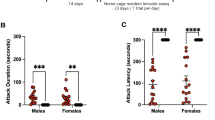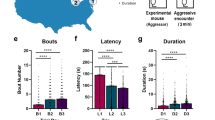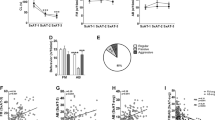Abstract
Repeated aggression is a frequent symptom of many psychiatric and neurological disorders, including obsessive-compulsive and attention deficit hyperactivity disorders, bipolar and post-traumatic stress disorders, epilepsy, autism, schizophrenia and drug abuse. However, repeated aggression is insufficiently studied because there is a lack of adequate models in animals. The sensory contact model (SCM), widely used to study the effects of chronic social defeat stress, can also be used to investigate the effects of repeated aggression. Mice with repeated positive fighting experience in daily agonistic interactions in this model develop pronounced aggressiveness, anxiety and impulsivity, disturbances in motivated and cognitive behaviors, and impairments of sociability; they also demonstrate hyperactivity, attention-deficit behavior, motor dysfunctions and repetitive stereotyped behaviors, such as jerks, rotations and head twitches. In this protocol, we describe how to apply the SCM to study repeated aggression in mice. Severe neuropathology develops in male mice after 20–21 d of agonistic interactions.
This is a preview of subscription content, access via your institution
Access options
Subscribe to this journal
Receive 12 print issues and online access
$259.00 per year
only $21.58 per issue
Buy this article
- Purchase on Springer Link
- Instant access to full article PDF
Prices may be subject to local taxes which are calculated during checkout




Similar content being viewed by others
References
Scott, J.P. Theoretical issues concerning the origin and causes of fighting. in The Physiology of Aggression and Defeat (eds. Eleftheriou, B.E. and Scott, J.P.) 11–42 (Plenum, 1971).
Moyer, K.E. Violence and Aggression: a Physiological Perspective (Paragon House, 1987).
Ramirez, J.M. Aggression: causes and functions. in Hiroshima Forum for Psychology 17, 21–37 (1996).
Fish, E.W., De Bold, J.F. & Miczek, K.A. Aggressive behavior as a reinforcer in mice: activation by allopregnanolone. Psychopharmacology (Berl) 163, 459–466 (2002).
Baron, R.A. & Richardson, D.R. Human Aggression (Plenum Press, 1994).
Lagerspetz, K.M.J. Studies on the aggressive behavior of mice. Ann. Acad. Sci. Fenn. Series B. 31, 1–131 (1964).
Scott, J.P. Agonistic behavior of mice and rats: a review. Am. Zool. 6, 683–701 (1966).
Brain, P.F. & Poole, A.E. Some studies in the use of 'Standard opponents' in intermale aggression testing in TT albino mice. Behaviour 50, 100–110 (1974).
Van de Poll, N.E., de Jonge, F., Van Oyen, H.G. & Van Pelt, J. Aggressive behavior in rats; effects of winning and losing on subsequent aggressive interactions. Behav. Processes 7, 143–155 (1982).
Parmigiani, S. & Brain, P.F. Effects of residence, aggressive experience and intruder familiarity on attack shown by male mice. Behav. Processes 8, 45–47 (1983).
Andrade, M.L., Kamal, K.B.H. & Brain, P.F. Effects of positive and negative fighting experience on behaviour in adult male mice. in House Mouse Aggression. A Model for Understanding the Evolution of Social Behaviour (eds. Brain, P.F., Mainardi, D. and Parmigiani, S.) 223–232 (Harwood Academic Publishers, 1987).
American Psychiatric Association. Diagnostic and Statistical Manual of Mental Disorders (DSM-IV-TR). (American Psychiatric Association, 2000).
Kudryavtseva, N.N. The sensory contact model for the study of aggressive and submissive behaviors in male mice. Aggress. Behav. 17, 285–291 (1991).
Kudryavtseva, N.N. Agonistic behavior: a model, experimental studies, and perspectives. Neurosci. Behav. Physiol. 30, 293–305 (2000).
Kudryavtseva, N.N. Sensory contact model: Protocol, control, applications. in Horizons in Neuroscience Research Vol. 3 (eds. Costa, A. and Villalba, E.) Ch. 4, 81–100 (Nova Science Publishers, 2011).
Kudryavtseva, N.N. Practice of research in agonistic behavior: Methods, methodology, interpretations. Monograph, Science-Centre (Nauka-Tsentr) (2012).
Kudryavtseva, N.N., Bakshtanovskaya, I.V. & Koryakina, L.A. Social model of depression in mice of C57BL/6J strain. Pharmacol. Biochem. Behav. 38, 315–320 (1991).
Kudryavtseva, N.N. & Avgustinovich, D.F. Behavioral and physiological markers of experimental depression induced by social conflicts (DISC). Aggress. Behav. 24, 271–286 (1998).
Keeney, A.J. & Hogg, S. Behavioural consequences of repeated social defeat in the mouse: preliminary evaluation of a potential animal model of depression. Behav. Pharmacol. 10, 753–764 (1999).
Berton, O. et al. Essential role of BDNF in the mesolimbic dopamine pathway in social defeats stress. Science 311, 864–868 (2006).
Boer, U. et al. CRE/CREB-driven up-regulation of gene expression by chronic social stress in CRE-luciferase transgenic mice: reversal by antidepressant treatment. PLoS ONE 2, e431 (2007).
Krishnan, V. et al. Molecular adaptations underlying susceptibility and resistance to social defeat in brain reward regions. Cell 131, 391–404 (2007).
Tsankova, N.M. et al. Sustained hippocampal chromatin regulation in a mouse model of depression and antidepressant action. Nat. Neurosci. 9, 519–525 (2006).
Bartolomucci, A., Fuchs, E., Koolhaas, J.M. & Ohl, F. Acute and chronic social defeat: stress protocols and behavioral testing mood and anxiety related phenotypes in mice. in Mood and Anxiety-Related Phenotypes in Mice (Neuromethods; ed. Gould, T.D.) Ch. 14, 261–275 (Humana Press, 2009).
Golden, S.A., Covington III, H.E., Berton, O. & Russo, S.J. A standardized protocol for repeated social defeat stress in mice. Nat. Protoc. 6, 1183–1991 (2011).
Kudriavtseva, N.N., Bakshtanovskaia, I.V. & Avgustinovich, D.F. The effect of the repeated experience of aggression in daily confrontations on the individual and social behavior of male mice. Zh. Vyssh. Nerv. Deiat. Im. I P Pavlova 47, 86–97 (1997).
Kudryavtseva, N.N., Bondar, N.P. & Avgustinovich, D.F. Association between experience of aggression and anxiety in male mice. Behav. Brain Res. 133, 83–93 (2002).
Kudryavtseva, N.N., Amstislavskaya, T.G. & Kucheryavy, S. Effects of repeated aggressive encounters on approach to a female and plasma testosterone in male mice. Horm. Behav. 45, 103–107 (2004).
Bondar, N.P. & Kudriavtseva, N.N. Impaired social recognition in male mice with repeated experience of aggression. Zh. Vyssh. Nerv. Deiat. Im. I P Pavlova 55, 401–407 (2005).
Kudryavtseva, N.N. in Perspectives on the Psychology of Aggression (ed. Morgan, J.P.) Nova Science Publishers, 35–64 (2006).
Kudryavtseva, N.N. Neurobiology of aggression: men and mice. Monograph, Science-Centre (Nauka-Tsentr) (2013).
Kudryavtseva, N.N. Mechanisms of agonistic behavior. Dr. Sci. Dissertation, Pavlov Institute of Physiology, RAS, Leningrad (1992).
Feldker, D.E.M. et al. The effect of chronic exposure to highly aggressive mice on hippocampal gene expression of non-aggressive subordinates. Brain Res. 1089, 10–20 (2006).
Veenema, A.H., Sijtsma, B., Koolhaas, J.M. & de Kloet, E.R. The stress response to sensory contact in mice: genotype effect of the stimulus animal. Psychoneuroendocrinology 30, 550–557 (2005).
Ropartz, P. The relation between olfactory stimulation and aggressive behaviour in mice. Anim. Behav. 16, 97–100 (1968).
Vishnivetskaia, G.B., Avgustinovich, D.F. & Kudriavtseva, N.N. Development of movement disorders in DBA/2J male mice under repeated experience of aggression. Zh. Vyssh. Nerv. Deiat. Im. I P Pavlova 63, 235–245 (2013).
Kudryavtseva, N.N. An experimental approach to the study of learned aggression. Aggress. Behav. 26, 241–256 (2000).
Kudryavtseva, N.N., Bondar, N.P. & Alekseyenko, O.V. Behavioral correlates of learned aggression in male mice. Aggress. Behav. 26, 386–400 (2000).
Smagin, D.A., Bondar, N.P. & Kudryavtseva, N.N. Repeated aggression and implications of deprivation in male mice. Psychopharmacol. Biol. Narcol. 10, 2636–2648 (2010).
Kudryavtseva, N.N. Straub tail, the deprivation effect and addiction to aggression. In Motivation of Health Behavior (ed. O'Neal, P.W.) Ch. 7, 97–110 (Nova Science Publishers, 2007).
Kudryavtseva, N.N., Smagin, D.A. & Bondar, N.P. Modeling fighting deprivation effect in mouse repeated aggression paradigm. Prog. Neuro-Psychopharmacol. Biol. Psychiatry 35, 1472–1478 (2011).
Kudryavtseva, N.N. Peculiarities in forming agonistic behavior in mice using a sensory contact model. Institute of Cytology and Genetics SD RAS, (1987).
Kudryavtseva, N.N., Avgustinovich, D.F., Bondar, N.P., Tenditnik, M.V. & Kovalenko, I.L. An experimental approach for the study of psychotropic drug effects under simulated clinical conditions. Curr. Drug Metab. 9, 352–360 (2008).
Kudryavtseva, N.N. Use of the 'partition' test in behavioral and pharmacological experiments. Neurosci. Behav. Physiol. 33, 461–471 (2003).
Kudryavtseva, N.N. Experience of defeats decrease the behavioral reactivity to conspecific in the partition test. Behav. Processes 32, 297–304 (1994).
Kudryavtseva, N.N. Partition test and sexual motivation in male mice. in Animal Behavior: New Research (eds. Weber, E.A. and Krause, L.H.) 57–72 (Nova Science Publishers, 2008).
Lister, R.G. The use of a plus-maze to measure anxiety in the mouse. Psychopharmacology (Berl) 92, 180–185 (1987).
Rodgers, R.J. & Cole, J.C. Anxiety enhancement in the murine elevated plus maze by immediate prior exposure to social stressors. Physiol Behav. 53, 383–388 (1993).
Kovalenko, I.L. & Kudryavtseva, N.N. Development of autistic spectrum symptoms under chronic social defeat stress in anxious male mice: effects of diazepam. Psychopharmacol. Biol. Narcol. 10, 2624–2635 (2010).
Porsolt, R.D., Bertin, A. & Jalfre, M. Behavioral despair in mice: a primary screening test for antidepressants. Arch. Int. Pharmacodyn. Ther. 229, 327–336 (1977).
McKinney, W.T. Jr. & Bunney, W.E.J. Animal model of depression. I. Review of evidence: implications for research. Arch. Gen. Psychiatry 21, 240–248 (1969).
Kudryavtseva, N.N. et al. Experimental studies of hereditary predisposition to the development of depression. in Animal Models of Biological Psychiatry (ed. Kalueff, A.) Ch. 5, 75–95 (Nova Science Publishers, 2006).
Kulikov, A.V., Kozlachkova, E.Y., Kudryavtseva, N.N. & Popova, N.K Correlation between tryptophan hydroxylase activity in the brain and predisposition to pinch-induced catalepsy in mice. Pharmacol. Biochem. Behav. 50, 431–435 (1995).
Kudryavtseva, N.N. & Bakshtanovskaya, I.V. Experience of defeat increases the susceptibility to catatonic-like state in mice. Behav. Processes 20, 139–149 (1989).
Lipina, T.V., Mikhnevich, N.V. & Kudriavtseva, N.N. The development of catatonic reactions in male mice of CBA/Lac strain: the effect of repeated experience of aggression and submission. Zh. Vyssh. Nerv. Deiat. Im. I P Pavlova 53, 88–93 (2003).
Lipina, T.V. & Kudriavtseva, N.N The study of explorative behavior in CBA/Lac male mice under influence of positive and negative social experience. Zh. Vyssh. Nerv. Deiat. Im. I P Pavlova 58, 194–201 (2008).
Hall, C.S. Genetic differences in fatal audiogenic seizures between two inbred strains of house mice. Heredity 38, 2–6 (1947).
Caramaschi, D., de Boer, S.F., de Vries, H. & Koolhaas, J.M. Development of violence in mice through repeated victory along with changes in prefrontal cortex neurochemistry. Behav. Brain Res. 189, 263–272 (2008).
Ginsberg, S.D. et al. Differential regulation of catechol-O-methyltransferase expression in a mouse model of aggression. Brain Struct. Funct. 216, 347–356 (2011).
Mondragon, R., Mayagoitia, L., Lopez-Lujan, A. & Diaz, J.-L. Social structure features in three inbred strains of mice, C57Bl/6J, Balb/cj and NIH: A comparative study. Behav. Neurol. Biol. 47, 384–391 (1987).
Avgustinovich, D.F., Gorbach, O.V. & Kudryavtseva, N.N. Comparative analysis of anxiety-like behavior in partition and plus-maze tests after agonistic interactions in mice. Physiol. Behav. 61, 37–43 (1997).
Bondar, N.P., Boyarskikh, U.A., Kovalenko, I.L., Filipenko, M.L. & Kudryavtseva, N.N. Molecular implications of repeated aggression: Th, Dat1, Snca and Bdnf gene expression in the VTA of victorious male mice. PLoS ONE 4, e4190 (2009).
Acknowledgements
This research was supported by the Russian Scientific Foundation, grant no. 14-15-00063.
Author information
Authors and Affiliations
Contributions
N.N.K. is an author of the SCM, oversaw the implementation of the overall projects concerning the study of repeated experience of aggression and defeats, carried out design of experiments and wrote the paper. N.N.K., D.A.S., I.L.K. and G.B.V. conducted the behavioral experiments and presented video files illustrating pathological behaviors.
Corresponding author
Ethics declarations
Competing interests
The authors declare no competing financial interests.
Supplementary information
Behavior of the C57BL/6J 20 d winners during the period of 5 min activation before agonistic interactions.
Winners demonstrate strong aggressive motivation (left compartment of the cage) as a reaction to the group-housed partner (right compartment of the cage). The group-housed partner is attempting to come to the partition. After partition removal the winner immediately attacks the partner. (MOV 3350 kb)
Behavior of the C57BL/6J 20 d winners during the period of 5 min activation before agonistic interactions.
Winners demonstrate strong aggressive motivation as a reaction to the 20 d. The loser does not approach the partition at all. After partition removal the winner immediately attacks the partner. There is a strong positive correlation between the total time spent near the partition as a reaction to the partner and the total attacking time or hostile behavior time during confrontation. (MOV 6717 kb)
Behavior of the DBA/2J 20 d winners (left compartment of the cage) during the period of 5 min activation before agonistic interactions with 20 d losers (right compartment).
The winners display chaotic movements in the cage without any attention to the partner in the next compartment of the cage. This behavior can be regarded as attention/deficit hyperactivity. There is no correlation between the total time spent near the partition as reaction to the partner and the total attacking time during the confrontation36. (MOV 5574 kb)
Behavior of the CBA/Lac 20 d winners during the period of 5 min activation before agonistic interactions (lower compartments of the cage) with 20 d losers (upper compartment).
All winners spent much time near the partition reacting to the losers. The winner in the left cage demonstrates stereotypic behaviors - turns around the axis of the body. (MOV 3565 kb)
Behavior of the C57BL/6J 20 d winner in unfamiliar cage. A group-housed male is used as a partner.
The winner demonstrates unusual repetitive backward movements. (MOV 3064 kb)
Jerks, head shakes, jumps, rotations, and hyperactivity demonstrated by the DBA/2J 20 d winners in agonistic interactions with 20 d losers.
The appearance of a large number of hyperkinetic movements manifested mostly in the form of sudden involuntary head movements (jerks), jumps with a turn were observed in the behavior of aggressive males during agonistic interactions36. (MOV 1229 kb)
Rights and permissions
About this article
Cite this article
Kudryavtseva, N., Smagin, D., Kovalenko, I. et al. Repeated positive fighting experience in male inbred mice. Nat Protoc 9, 2705–2717 (2014). https://doi.org/10.1038/nprot.2014.156
Published:
Issue Date:
DOI: https://doi.org/10.1038/nprot.2014.156
This article is cited by
-
Influence of rearing environment on the development of social behavior in male water voles (Arvicola amphibius)
Mammalian Biology (2021)
-
Dopamine response gene pathways in dorsal striatum MSNs from a gene expression viewpoint: cAMP-mediated gene networks
BMC Neuroscience (2020)
-
Rage Against the Machine: Advancing the study of aggression ethology via machine learning.
Psychopharmacology (2020)
-
Effects of Chronic Caffeine Administration on Behavioral and Molecular Adaptations to Sensory Contact Model Induced Stress in Adolescent Male Mice
Behavior Genetics (2020)
-
Differentially Expressed Genes of the Slc6a Family as Markers of Altered Brain Neurotransmitter System Function in Pathological States in Mice
Neuroscience and Behavioral Physiology (2020)
Comments
By submitting a comment you agree to abide by our Terms and Community Guidelines. If you find something abusive or that does not comply with our terms or guidelines please flag it as inappropriate.



